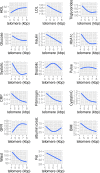Leukocyte Telomere Length in Relation to 17 Biomarkers of Cardiovascular Disease Risk: A Cross-Sectional Study of US Adults
- PMID: 27898678
- PMCID: PMC5127504
- DOI: 10.1371/journal.pmed.1002188
Leukocyte Telomere Length in Relation to 17 Biomarkers of Cardiovascular Disease Risk: A Cross-Sectional Study of US Adults
Abstract
Background: Leukocyte telomere length (LTL) is a putative biological marker of immune system age, and there are demonstrated associations between LTL and cardiovascular disease. This may be due in part to the relationship of LTL with other biomarkers associated with cardiovascular disease risk. However, the strength of associations between LTL and adiposity, metabolic, proinflammatory, and cardiovascular biomarkers has not been systematically evaluated in a United States nationally representative population.
Methods and findings: We examined associations between LTL and 17 cardiovascular biomarkers, including lipoproteins, blood sugar, circulatory pressure, proinflammatory markers, kidney function, and adiposity measures, in adults ages 20 to 84 from the cross-sectional US nationally representative 1999-2002 National Health and Nutrition Examination Survey (NHANES) (n = 7,252), statistically adjusting for immune cell type distributions. We also examine whether these associations differed systematically by age, race/ethnicity, gender, education, and income. We found that a one unit difference in the following biomarkers were associated with kilobase pair differences in LTL: BMI -0.00478 (95% CI -0.00749--0.00206), waist circumference -0.00211 (95% CI -0.00325--0.000969), percentage of body fat -0.00516 (95% CI -0.00761--0.0027), high density lipoprotein (HDL) cholesterol 0.00179 (95% CI 0.000571-0.00301), triglycerides -0.000285 (95% CI -0.000555--0.0000158), pulse rate -0.00194 (95% CI -0.00317--0.000705), C-reactive protein -0.0363 (95% CI 0.0601--0.0124), cystatin C -0.0391 (95% CI -0.0772--0.00107). When using clinical cut-points we additionally found associations between LTL and insulin resistance -0.0412 (95% CI -0.0685--0.0139), systolic blood pressure 0.0455 (95% CI 0.00137-0.0897), and diastolic blood pressure -0.0674 (95% CI -0.126--0.00889). These associations were 10%-15% greater without controlling for leukocyte cell types. There were very few differences in the associations by age, race/ethnicity, gender, education, or income. Our findings are relevant to the relationships between these cardiovascular biomarkers in the general population but not to cardiovascular disease as a clinical outcome.
Conclusions: LTL is most strongly associated with adiposity, but is also associated with biomarkers across several physiological systems. LTL may thus be a predictor of cardiovascular disease through its association with multiple risk factors that are physiologically correlated with risk for development of cardiovascular disease. Our results are consistent with LTL being a biomarker of cardiovascular aging through established physiological mechanisms.
Conflict of interest statement
I have read the journal's policy and the authors of this manuscript have the following competing interests: JL is a cofounder and consultant to Telomere Diagnostic Inc. (formerly Telome Health).
Figures





Similar articles
-
Less Than Ideal Cardiovascular Health Is Associated With Shorter Leukocyte Telomere Length: The National Health and Nutrition Examination Surveys, 1999-2002.J Am Heart Assoc. 2017 Feb 2;6(2):e004105. doi: 10.1161/JAHA.116.004105. J Am Heart Assoc. 2017. PMID: 28154163 Free PMC article.
-
Adiposity and Leukocyte Telomere Length in US Adults by Sex-Specific Race/Ethnicity: National Health and Nutrition Examination Survey.Ethn Dis. 2020 Jul 9;30(3):441-450. doi: 10.18865/ed.30.3.441. eCollection 2020 Summer. Ethn Dis. 2020. PMID: 32742149 Free PMC article.
-
Modifiable mediators associated with the relationship between adiposity and leukocyte telomere length in US adults: The National Health and Nutrition Examination Survey.Prev Med. 2020 Sep;138:106133. doi: 10.1016/j.ypmed.2020.106133. Epub 2020 May 18. Prev Med. 2020. PMID: 32439486 Free PMC article.
-
Telomeres and cardiovascular disease risk: an update 2013.Transl Res. 2013 Dec;162(6):371-80. doi: 10.1016/j.trsl.2013.05.004. Epub 2013 Jun 7. Transl Res. 2013. PMID: 23748031 Review.
-
A systematic review of leukocyte telomere length and age in adults.Ageing Res Rev. 2013 Mar;12(2):509-19. doi: 10.1016/j.arr.2013.01.003. Epub 2013 Jan 16. Ageing Res Rev. 2013. PMID: 23333817 Review.
Cited by
-
The negative association between sodium-driven nutrient pattern and telomere length: the chain mediating role of diastolic pressure and waist circumference.Aging Clin Exp Res. 2024 Oct 5;36(1):201. doi: 10.1007/s40520-024-02852-1. Aging Clin Exp Res. 2024. PMID: 39368029 Free PMC article.
-
Telomere length and metabolic syndrome traits: A Mendelian randomisation study.Aging Cell. 2021 Aug;20(8):e13445. doi: 10.1111/acel.13445. Epub 2021 Jul 27. Aging Cell. 2021. PMID: 34312982 Free PMC article.
-
Cytomegalovirus Infection and Its Relationship with Leukocyte Telomere Length: A Cross-Sectional Study.Mediators Inflamm. 2021 Feb 15;2021:6675353. doi: 10.1155/2021/6675353. eCollection 2021. Mediators Inflamm. 2021. PMID: 33628118 Free PMC article.
-
Mendelian randomization implies no direct causal association between leukocyte telomere length and amyotrophic lateral sclerosis.Sci Rep. 2020 Jul 22;10(1):12184. doi: 10.1038/s41598-020-68848-9. Sci Rep. 2020. PMID: 32699404 Free PMC article.
-
Leukocyte telomere length and obesity in children and adolescents: A systematic review and meta-analysis.Front Genet. 2022 Sep 7;13:861101. doi: 10.3389/fgene.2022.861101. eCollection 2022. Front Genet. 2022. Retraction in: Front Genet. 2023 Sep 04;14:1285214. doi: 10.3389/fgene.2023.1285214. PMID: 36160016 Free PMC article. Retracted.
References
MeSH terms
Substances
Grants and funding
LinkOut - more resources
Full Text Sources
Other Literature Sources
Research Materials

